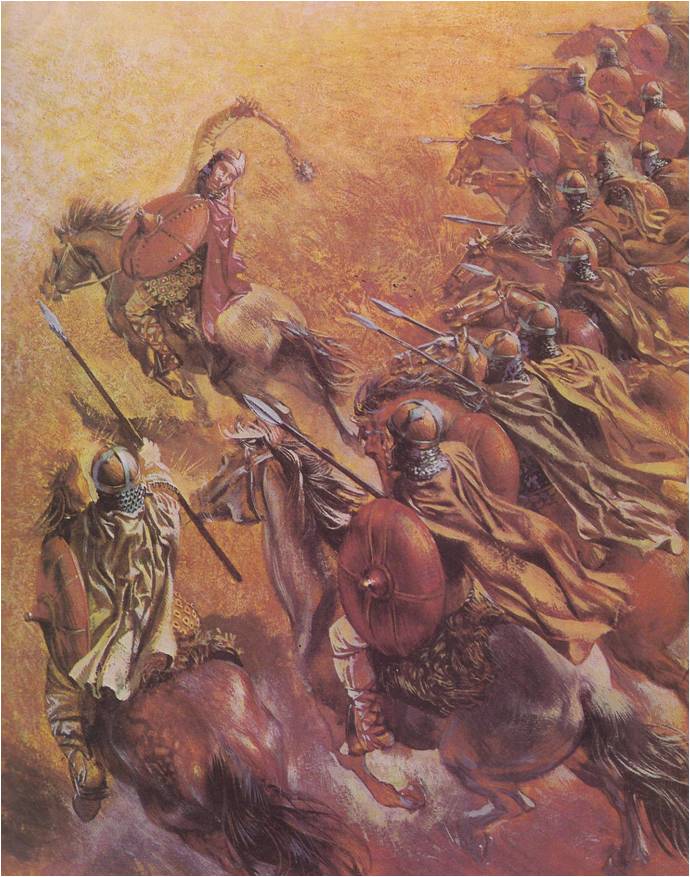THE FIRST SIGN of the approaching Roman army was a thin column of dust. It rose like smoke from behind the jagged Thracian hills of Northern Greece, which sheltered the Visigoths’ encampment. Moments later, the Visigoths, or German barbarians, as the Romans called them, could feel the ground tremble with the tread of the imperial legions. The Romans were advancing, forty thousand strong, under the personal command of the Emperor Valens.
Within the Visigoths’ barricade of wagons, all was confusion. Chieftains bellowed, calling their clans together. Sturdy Visigothic warriors dragged the wagons closer together in a protective circle. Horses neighed and whinnied as their riders leaped astride them; swords were unsheathed and lances brandished. A courier spurred away from camp to summon the main body of Visigothic cavalry, foraging at some distance. It was A.D. 378 and the battle of Adrianople was about to begin.
Trumpets blared and the close-packed Romans marched straight toward the barbarian enemy. Suddenly, there was a thunder of hooves on the left. A great swarm of Visigothic horsemen, summoned from their foraging expedition, galloped over the hillside. They swooped down on the Romans, as an eyewitness described it, “like a thunderbolt which strikes on a mountain top and dashes away all that stands in its path.” More horsemen poured in from the right and the front, pressing the tightly massed Romans into a death trap. The men of the legions could scarcely raise their arms to strike a blow. Again and again the horsemen charged, brandishing lance and sword. When night fell, forty thousand Roman soldiers lay dead upon the field, together with the grand master of the infantry and cavalry, the count of the palace, thirty-five commanders of horse and foot corps and the Emperor Valens himself. This great defeat was to mark the beginning of the end of the mighty Roman Empire.
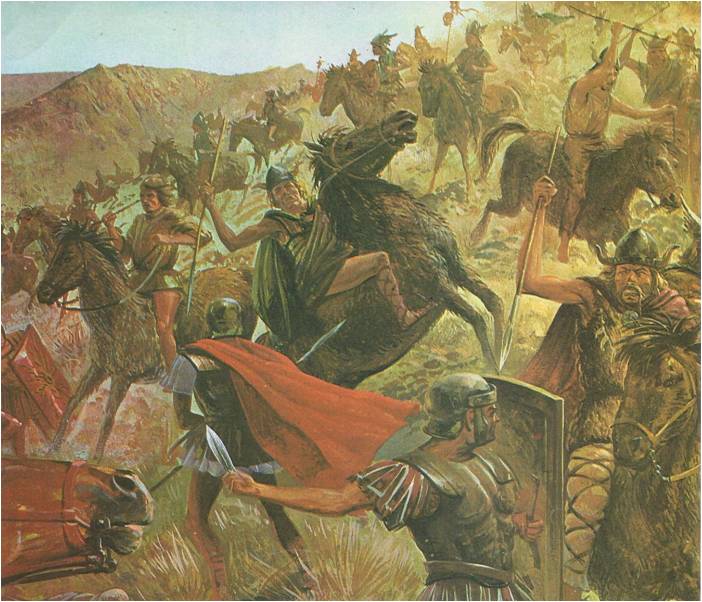
The city of Rome had been the cornerstone of the Roman empire for centuries. Rome controlled most of the then known world — Italy, Spain, Gaul (Modern France), Switzerland, Belgium and large parts of Britain, Germany, Austria, the Balkans, Greece, Asia Minor, the near East, Egypt, and North Africa. Roman legions guarded the colonies. Roman justice prevailed in the courts. Roman customs were admired and copied. Even a succession of weak emperors had not disturbed the order and stability of Roman civilization and Roman citizens believed they would always enjoy security. Then came their defeat by the Visigoths at Adrianople.
THE BARBARIANS
The Visigoths were only one of the many German tribes which had drifted down from the forests and marshes of northern Europe. There were also the Ostrogoths, Franks, Alemanni, Burgundians, Lombards and Vandals. As early as 50 B.C., Julius Caesar had recognized that these tribes could be dangerous enemies. He had laid down a rule that under no circumstances were they to be allowed to cross the Rhine or Danube rivers.
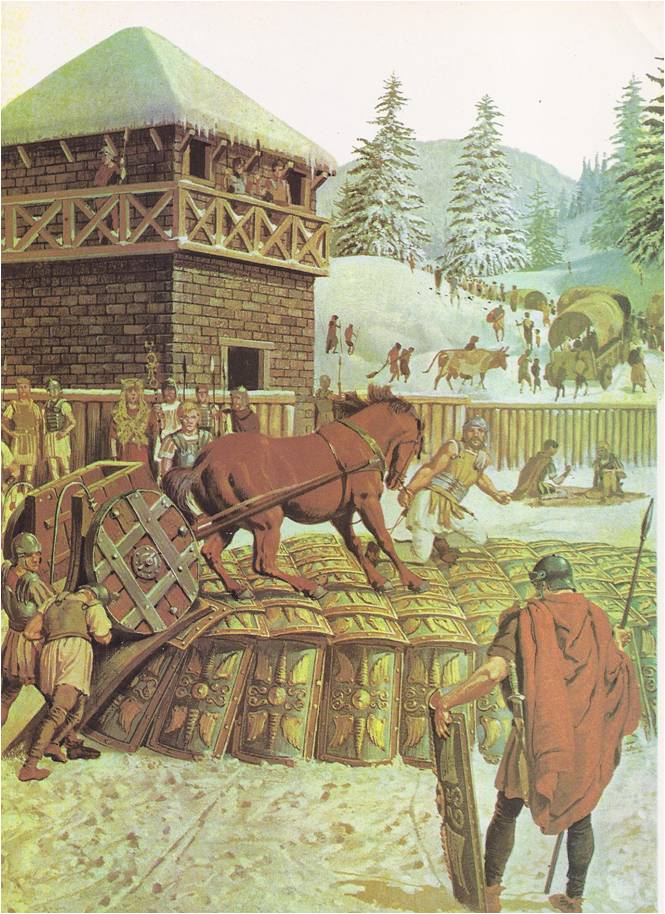
The German barbarians were fierce, restless people and hardy warriors. Tall, blue-eyed, with tangled reddish-blond hair, they were described as giving over their time “to sleep and eating” when not at war or engaged in hunting. They were men of action, not thought. They lived in huts of rough-hewn timbers, or in caves and clothed themselves in animal skins. Although they owned animals and farmed here and there, they mostly lived a nomadic life, moving from place to place.
Within a tribe were several clans. Each was ruled by a chieftain, chosen for his ancestry and valour. These early German chiefs, or kings, did not have unlimited power. They were expected to lead by example and their decisions could be overruled by a vote of the free warriors of the clan. Each clan was held responsible for the offenses and crimes of its members and this led to many interclan feuds and tribal wars. The unforgivable crime was cowardice. It was a disgrace for a warrior to leave his shield on the battlefield without dying beside it.
The Germans loved war and hunting, they also loved weapons. They had heavy battle axes of metal or stone, daggers, spears, bows and short swords called seax (from which the word Saxon probably comes). They went into battle protected merely by light chest plates of brass-studded leather. Sometimes they wore no clothes at all. They often rushed to attack singing loudly in their hoarse, deep voices, terrifying their enemies.
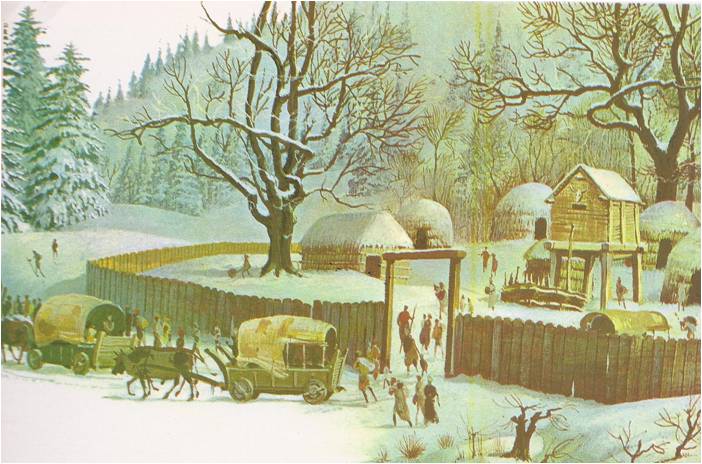
The Germans’ pagan gods were super-beings who also reveled in war and the hunt. Among them were Tyr, the war god and Thor, the thunder god who wielded a mighty ax. Thor was worshipped on a special day of the week — Thorsday, or Thursday. Wodensday, or Wednesday, was sacred to Woden, or Wotan, the all-powerful and all-wise guardian of the land and law and order. Wotan was also Lord of Valhalla, the place to which dead heroes were carried by warrior maidens, the Valkyries, there to feast and fight throughout eternity.
MIGRATIONS OF THE TRIBES
More than 150 years before the battle of Adrianople, the various German tribes began to push down from their tree-choked, swampy northern lands toward the frontiers of the Roman empire. The Visigoths moved southward in Western Europe. In the east, near the Black Sea, the Ostrogoths migrated toward the Balkans. With them they brought a device called stirrups, which enabled a man to use a horse as an instrument of battle. The Goths quickly adopted the innovation, which was to change the entire character of warfare. Indeed, the Gothic horseman was to be the ancestor of the mounted knight of the Middle Ages.
As the Visigoths and the Ostrogoths, together with the Salian Franks in the area of the Rhine, the Vandals in Hungary and other tribes across Europe, pressed south toward the Roman borders, seeking new grazing lands, a warmer climate, or escape from hostile neighbours, the Romans relaxed their age old rule. They permitted the barbarians to cross over the frontiers. Soon, Roman commanders were gladly accepting German warriors as recruits in Roman armies. The Roman government permitted German colonists to settle on public lands or cultivate unused fields of private landowners inside the borders of the empire. By AD. 378, the former barbarians made up a large part of the Roman military force and held important positions in the Roman government.
ATTILA THE HUN
It is possible that the German barbarians might have become absorbed into the Roman Empire without violence, if a new and savage group of nomads had not appeared on the scene. They were the Huns, who swept west from the Asian steppes, spreading death and destruction. Europe had known nothing like them before. Described as “fiercer than ferocity itself,” the Huns poured across China, central Asia, Russia and pushed on into Europe. Wherever they went, they left behind them ravaged fields, smoking ruins and countless dead. The Hun warriors spent their lives on horseback; there, an early historian wrote, “they buy and sell, they take their meat and drink and there they recline on the narrow neck of their steed.” Their scarred weather-beaten faces, their garments made of foul-smelling leather, their rat-skin helmets, terrified all who saw them. The Huns’ most famous leader, Attila, was called the “scourge of God”– his horrified victims believed God had sent him as punishment for their sins. From his palace court in Hungary he ruled over millions of square miles and held the power of life and death over half the known world.
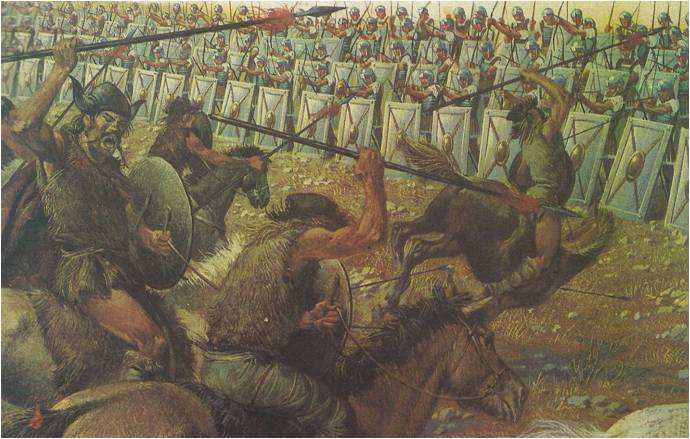
To escape the terrible Huns, the Visigoths asked permission of the Roman Emperor Valens to settle in the empire. He said they could enter Northern Greece, provided they gave hostages and surrendered their arms, but the Roman officials in charge of the Gothic settlements accepted bribes and allowed the tribesmen to keep their arms. In addition, the Romans cheated the Visigoths by selling them food at extremely high prices. The Visigoths rebelled and a Roman army was sent to push them back to the frontier. The army failed and in AD. 578 Valens personally took command of his legions. He marched to Adrianople, confident that he would defeat the Visigoths and their allies, the Ostrogoths. After all, Roman armies had always defeated the barbarians. This time, however, it was the Romans who were defeated and for the next few generations, hordes of barbarians would pour across the empire’s borders and even invade the city of Rome.
The Romans themselves did not realize that their civilization was about to fall apart. After the first shock of the defeat at Adrianople, they again took up the routine of their lives. Crowds swarmed to the Colosseum to watch the games; Roman gentlemen argued politics in the Forum and Roman ladies gossiped about the latest fashions.
However, the Visigoths were on the move, united under a fearless chieftain named Alaric. He attacked Constantinople, but when he failed to conquer the city, he slowly moved his armies toward Italy. Meanwhile, the Vandals, after ravaging Gaul for three years, moved south into Spain and the Franks, Burgundians and Alemanni spread to Germany and Gaul. Little by little, Rome was being encircled by the barbarian tribes.
The Huns renewed their pressure in the East and Alaric tried to escape them. He asked permission from the Roman emperor to move his Visigoth tribes south to Italy. He also demanded payment for the military help his people had given the Romans. When the emperor refused his demands, Alaric marched on Rome and in A.D. 410, the Visigoths sacked the capital.
“TOMB OF THE PEOPLES”
Shock waves rippled to the remotest corners of the empire. By this time Christianity had been the official religion of Rome and her provinces for more than a hundred years and the Christian leaders were horrified. St. Jerome, who was translating the Hebrew Scriptures into Latin, grieved that the “mother (Rome) should become the tomb of the peoples.” St. Augustine undertook his mightiest work, The City of God, to prove that Christianity was not responsible for the evil things that were happening.
THE EMPIRE FALLS
A year after his sack of Rome, Alaric died and the city and the empire breathed easier. The Visigoths were given south central Gaul for their own lands and from there they spread into Spain. The Vandals, meantime, had crossed the narrow Straits of Gibraltar from Spain to North Africa. At first allies of Rome, they finally turned against her, led by their small, lame, merciless king, Gaiseric. In 455, Gaiseric’s Vandals invaded Rome; for two weeks they plundered, burned, looted and killed. From their senseless and vicious destruction of civic buildings and priceless works of art comes the word “vandalism,” meaning the malicious destruction of useful or beautiful things.
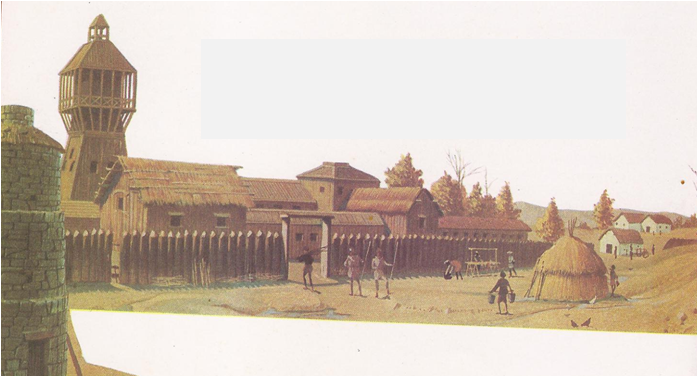
The empire now sank into despair and confusion; political power belonged to whoever could grab fastest and hang on hardest. For the next thirty years, German chieftains killed and deposed one another in a constant struggle to rule Rome and Italy. Elsewhere, the frontier territories were being broken up into separate states. Lombards held the north of Italy. The Visigoths held Spain and Southern Gaul. Salian Franks ruled central and northern Gaul and beyond them, to the east, were the Ripaurian Franks and the Alemanni. The Burgundians dominated the Rhone Valley and the Vandals were spread out across the rim of North Africa.
In Britain, after the withdrawal of Roman troops, the land was overrun by tribes of savage Picts, Scots and Saxons. After almost 400 years of Roman rule, the Britons had forgotten how to defend themselves. They tried to stem the invasion of their land, but they were no match for the fierce barbarians. The worst of the barbarians were the Saxons. A fearful Briton described them as “ferocious . . . of unspeakable name, hateful to God and man.”
Centralized government broke down completely. Commerce and trade were at a standstill. Roads crumbled into ruin or were unsafe for travel because of cutthroats. Handsome and luxurious cities built by the Romans, such as Bath, were abandoned and became the haunt of bats and small night animals. Villages were attacked and burned; families massacred or scattered. Crops rotted in the fields or on the vines because there was no one to harvest them; the farmers were dead or in hiding. Schools were shut down. Churches stopped holding services. The Britons huddled in caves, or fled to the mountains of Wales, or escaped to Brittany. They complained to God: “Thou lettest us be eaten up like sheep and hast scattered us amongst the heathen.”
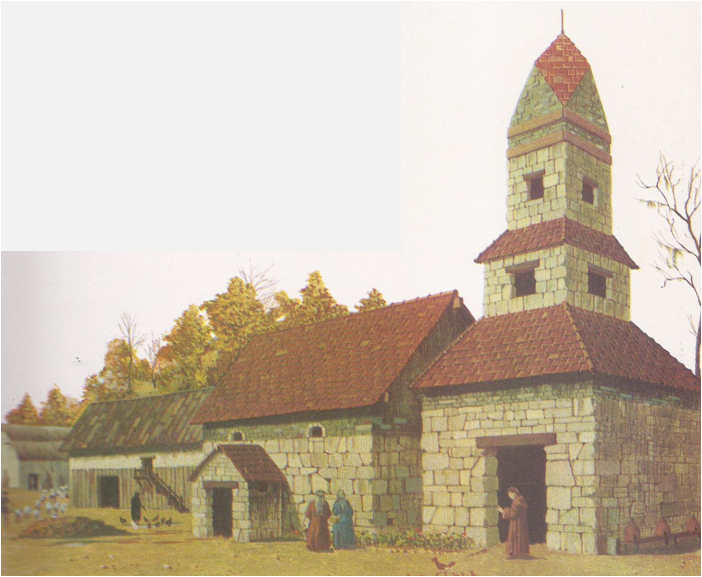
THE DARK AGES
Furthermore, what happened in Britain also happened elsewhere; there was desolation everywhere in Europe. Few remnants of Roman civilization survived. Towns and roads fell into ruin and the people were often hungry. Brigands roamed the countryside and it seemed that the disorder would never end. This time, which would last for 400 years, came to be called the Dark Ages and yet, in 481, only twenty years after the sack of Rome by the Vandals, the Salian Franks crowned a king who was to lay the foundation for Western Europe as it is today.
This king, whose name was Clovis, was of the line of Merovingian kings descended from Meroveus, ruler of the Salian Franks. The Franks, unlike the Visigoths, Ostrogoths‚ and other Germanic tribes, had not wandered all over the European continent searching for a home. They had settled in central and northern Gaul and allied themselves with Rome. When Clovis took the throne, he set out to conquer the surrounding territories and tribes. He was successful and his kingdom became the basis of modern France, which takes its name from the Franks, Clovis’ tribe.
CHRISTIAN KING
Clovis’ most important contribution to his people and to Western Europe, was his conversion from German paganism to Christianity. By committing himself and his subjects to the Christian faith, he gained the support of the large Christian population of the entire West. Moreover, he gained the support of the Church fathers in Gaul.
THE HAMMER
The Church and the pope were the links to the culture and civilization of the ancient world. The Church fathers preserved the books and records of the past; they also copied them by hand, illustrating them with beautiful and elaborate designs. Churches and monasteries became centres of learning and people looked to the clergy for decisions in all kinds of matters. Kings depended on them for help and advice in government. Few kings of the Dark Ages could read and write; a ruler might give an order, but he needed a scholarly monk or priest to write it down so that it would become law.
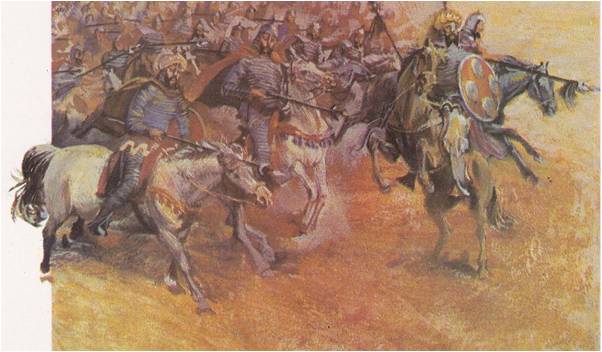
The Church continued to support the descendants of Clovis, although they were weak and cruel and accomplished little. In later years, the Merovingian kings became mere figureheads and the real ruler of the Franks was called the “Mayor of the Palace.” The most powerful Mayor of the Palace was Charles Martel, who was nicknamed “The Hammer” because of his strength in battle. He tried to unite all the Frankish nobles under one head, but they resisted. Each chief was jealous of his own territory and his own power. The pope and the Church supported Charles, as they did his son, Pepin, who was called Pepin the Short. Pepin gained the crown his father had never been able to win. In 752, at Soissons, he was chosen king of all the Franks. He was the first western king to be anointed by a pope and the true founder of the Carolingian dynasty‚ named for his father, Charles. It was Pepin’s son Charlemagne who would emerge as the greatest leader of the West since Julius Caesar. He was to push back the shadows of the Dark Ages and usher in a new era of civilization.
